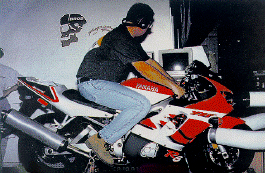 |
IT'S CRUNCHTIME, ladies and gentlemen. After gathering
hard information on the exact amount of airbox pressure present
at speed in various ram-air-equipped sportbikes, via
Pi Research's System
3 data-acquisition system, the time has come to strap these
bikes to the dyno and see how much additional power is really available.
This is where Sport Rider finally answers the question of whether
all this ram-air horsepower hype is a measurable performance increase
or nothing more than advertising smoke and mirrors.
We took the ram air data, seven
current sportbikes and the Pi data-acquisition system to
Two Brothers Racing in
Santa Ana,
California, where proprietor Craig Erion would run the bikes
on his Factory Pro EC997a Eddy
Current dyno. The Eddy Current dyno was chosen because of its
ability to hold a steady rpm; this made it a lot easier to set the
correct airbox pressure, compared with the common Dynojet dynos
that can only make a complete run through the rpm range. With the
Pi System 3, measuring the airbox pressure at speed for the first
segment of our ram air test was a simple task. And its sophisticated
software permits the user to view the pressure data in real time
using a laptop computer. This gave us the chance to set the pressure
on the dyno to the same parameters derived from the previous top-speed
test.
Our biggest obstacle to completing
this experiment was figuring out a way to force enough air into
each of the airboxes to simulate the pressure encountered at speed
while running on a dynamometer. There is an incredible amount of
wind energy a 150 mph. If you've ever popped up out of the bubble
while braking for Turn One at Daytona, or even stuck your hand out
of a car's window while traveling faster than 130 mph, you know
what we mean. We required more than a fan setup that ran up huge
cfm (cubic feet per minute) numbers. It would need to supply that
volume at pressures above ambient, requiring a large, high-horsepower
fan and the necessary ducting - not something readily obtained without
spending huge amounts of money, nor easily built and mounted in
the limited space and time we had available. Several fan options
were tried but none could provide the amount of pressure we needed.
The setup we finally used may seem
a bit unorthodox but it definitely gave us the necessary
amount of wind energy and pressure. A pair of huge 185 cfm portable
air compressors normally used with jackhammers were employed, and
the requisite three-quarter-inch hoses directed the airflow. For
the smaller bikes, we only needed to direct one compressor hose
at a distance from the ram-air inlet to get the necessary pressure.
The larger bikes, however, required us to use both hoses and, in
some cases, seal up one side of the ram-air inlet while force-feeding
the other. It should be noted that Eddy Current dynos typically
give horsepower readings 15-20 percent lower than the more common
Dynojet dyno readings. We started each run at 7000 rpm (both with
and without ram-air assist), since we figured all of our top-speed
data was gathered using full throttle and anything less than 7000
rpm in top gear would offer inconsequential ram-air pressure/data.
Also, although many will argue that using air compressors brings
up the issues of heat (compressing air raises its temperature) and
moisture (compressing air also condenses moisture in that portion
of air), these graphs are basically relative in nature and the increase
in air temperature and amount of moisture condensation present were
negligible.
Unfortunately, two bikes that were present
during the top-speed data sessions had to be returned before we
could begin the dyno sessions. Both the Kawasaki ZX-7R and ZX-9R
are missing from these tests. However, we did manage to procure
a Honda CBR600F4 and Kawasaki ZX-6R to take their places.
On each of the dyno graphs,
the bold lines represent ram-air-assisted readings - solid for horsepower,
dotted lines for torque. As we stated in "Ram Air Test: Part One"
in our October issue, the results will definitely surprise you.
YAMAHA YZF-R6
Here is obvious proof that ram air
works on smaller-displacement engines. Ram air helps the
YZF hold its peak power higher and longer (12,000-14,000 rpm), and
the torque curve is higher and flatter as well. This isn't just
an incremental increase on top, either. We're talking about an average
difference of five horsepower through the midrange and a far more
usable power spread. The ram-air assisted reading would probably
be higher at 13,000 rpm, but we were unable to generate the required
airbox pressure on that particular run at that point. To give a
relative reference, without ram air the Yamaha registered -11 millibars.
Again, remember the lower peak horsepower reading of 84.4 is due
to the Eddy Current dyno.
(see True
HP Scale explanation)
SUZUKI TLIOOOR
It was difficult to determine what the average
peak pressure was in the Suzuki TL-R's airbox (check out its graph
in "Ram Air: Part One," October '99), so we decided to stick with
12mb. Although we were skeptical at first, it's fairly apparent
ram air works on V-twins, too. The horsepower and torque curves
are well above their non-ram-air counterparts, with a seven horsepower
bump at 10,000 rpm. It should be noted that the sealing on the Suzuki
ram-air components (specifically where the ducts route into the
airbox) is less than satisfactory. We encountered substantial leakage
and estimate that peak pressure might be higher if the connection
points had a more effective seal. The non-ram-aired TL-R registered
-19mb for relative comparison purposes.
SUZUKI GSX-R750
The GSX-R750 is another case where ram air
helps the engine hold its peak power higher and longer. The dip
at 10,000 rpm on the ram-air graph is the result of a pressure glitch.
We had a problem getting the correct Millibar setting at that rpm,
in addition to a persistent exhaust gasket leak. Note the power
peak builds earlier and carries much farther compared with the non-ram-air
graph. The GSX-R also suffered from leakage around the airbox/ram-air
ducts. Again, overall peak pressure could be higher if the componentry
had a better seal. Without ram air, the GSX-R drained the airbox
to the tune of -11mb.
RAM AIR HONDA CBR1100XX
Well, what would you rather have - 115 horsepower
or 122 horsepower? The CBR-XX obviously reacts well to ram-air induction.
The horsepower and torque curves literally mimic the non-ram-air
graphs, only with a five to seven horse power increase and three
to five additional foot-pounds of torque. It should be noted the
Honda XX's ram-air system is one of the most efficient on the market,
showing immediate power gains well before the 7000-rpm starting
mark and posting high-pressure readings during our top-speed test.
For comparative purposes, the CBR-XX's pressure reading without
ram-air assist at full-throttle/top rpm was -8mb
SUZUKI GSX1300R HAYABUSA
Even though the Hayabusa ram-air-assisted
read posted median pressure numbers during our top-speed and didn't
build pressure beyond ambient until 145 mph, it's apparent that
any internal combustion motor benefits from ram-air induction. The
reason the power curve is tailing off a bit around 9500 rpm is because
the Suzuki's mondo engine was basically beginning to require more
air than we could feed it at that point. It was the only motorcycle
we ram-air-dynoed that left both compressors gasping for breath.
And again, the Hayabusa suffered from leakage around the airbox/ram-air
duct junctions, which possibly prevented it from posting higher
numbers.
KAWASAKI ZX-6R
After witnessing the high pressure readings
garnered by both Kawasakis during our top-speed tests in the first
session, we were anxious to see what another ZX-R could do on the
dyno. Unfortunately, we ran into a problem. As the revs started
to climb beyond 10,000 rpm, we couldn't get the Kawasaki to run
cleanly.It was obvious the float-bowl vents weren't getting the
same airstream pressure as the airbox during our dyno runs. Without
ram air, the ZX-6R ran perfectly and posted excellent power numbers.
No matter what we tried, we couldn't get our simulated pressurization
to work with the Kawasaki's ram-air system properly. It was frustrating.
If we would have had more time to fabricate ducting that enshrouded
the ram-air inlets, we're confident our ram-air simulation would've
worked. Still, the ZX-6R shows the initial signs of definite power
gains up to 10,000 rpm. And judging by the excellent graphs drawn
from our top-speed tests of the 7R and 9R, it's a sure bet the ZX-6R
would have set the pace as far as showcasing the benefits of ram-air
induction.
Copyright SPORT RIDER / DECEMBER 1999
|
|
 |
|




